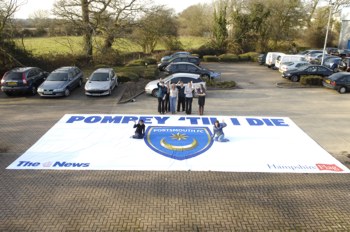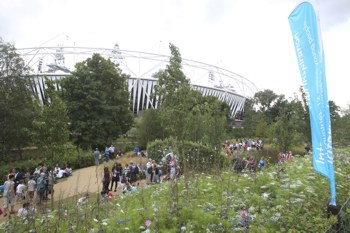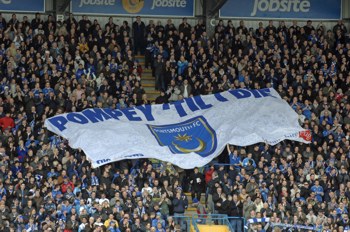Flag production: in-house or outsource?
The demand for flags is on the up as the nation increasingly marks sporting events, royal celebrations and occasions of all kinds with flags, banners and bunting.

2012 was an exceptional year for the industry thanks to the Queen's Diamond Jubilee and the Olympics and Paralympics, and for sign makers the temptation to diversify into flag production is now stronger than ever. But is it a viable business option and what are the pros and cons?
Graham Wilkinson, Managing Director of Hampshire Flag Company writes about the highs and lows of manufacturing flags.
Entering the flag market in 2013 is an appealing prospect for the sign industry especially as flag sales are increasing year on year. In a tough financial environment, keeping one step ahead of the competition is essential and embracing this growth by producing flags in-house seems a logical way for sign makers to set themselves apart - and the key to business success.
Being aware of new opportunities and areas of potential growth does mean looking at the big picture, considering both the positives and the pitfalls.
There is a growing push by the sign industry to enter the fabric market but it does face a number of barriers - primarily experience, investment and skilled staff. The biggest barrier by far is the heavy investment in plant that is required to set up a cost effective production process. However the return on this investment is potentially very low.
Dye sublimation printing
Sign makers are looking at entry level costs of around £25k for print equipment. These machines, which are not industrial grade, would be all-in-one dye sublimation machines with low UV resistance and a less intense finish.
The entry level machines do require using more expensive production materials, dyes and papers. Be aware that with cheaper machines there are reliability issues and lower product quality. An advantage of using a entry level machine however is a shorter turnaround time as it is only a two-point process - printing and finishing - requiring just two machines.
Disperse dye printing
Hampshire Flag Company has spent in excess of £0.5m on production, printing and finishing machinery for the textiles side of the business. Our disperse dye printing is a five-point process - print, bake, wash, dry and finish.
The process is more time intensive than using dye sublimation however, as we need to use four or five machines - digital textile printer, oven, automated roll to roll washer and drier, Zund G3 cutting machine and a sewing machine.
Materials matter
Knowing about fabrics before you decide on the machinery is important. Sign makers may be told by the machine salesperson that it is fine to use a standard untreated fabric, but this could shrink during the process.
You will need to use a treated pre-calibrated fabric. At Hampshire Flag, all the materials we use are treated and pre-calibrated.
Textile costs can be high so one of the biggest tips is to check the cost of the textiles required for the process you will be using before buying the machine. In addition to textile costs the quality of consumables, or inks, is of primary importance so always use branded guaranteed dyes where possible.



The finish line
Unlike most sign products the cutting and stitching of textiles, or the finishing, is a much more involved process as the fabrics are difficult to handle and require a dedicated machine operator. So this aspect of flag production needs careful consideration.
Finishing will require not only the purchase of the industrial sewing machines, which cost around £1,500.00 each, but specialist skills from experienced machinists.
However this full time wage will result in a substantial increase in overheads. Hampshire Flag currently employs nine machinists and four print operators.
Sign makers' expertise lies in handling PVC or rigid materials but it takes experience to successfully work with textiles.
A balancing act
The production environment also needs fine tuning in light of health and safety issues with regards to chemicals and pollutants in the air - so air purification and extraction machinery is an additional yet essential investment by law and for the well-being of your staff.
It is also essential as the print production needs to take place in a temperature and humidity controlled environment. If the humidity is not controlled it can affect the bleed of the print and the handling of the textile by the machinery. However if the atmosphere is too dry, it will affect the efficiency of the print heads.
Food for thought...
For a sign company to justify an investment of £25K for the initial machinery, the sales turnover would need to be excess of £100K. And as flag production is a seasonal business, in which the summer months are extremely busy with the rest of the year much quieter, year-round production and economies of scale are not guaranteed.
More than 25% of our business is with trade partners with which we see a year on year increase, and a high proportion of these are repeat customers.
Hampshire Flag is always looking for potential partners to sell our products and the sign industry has proved to be a reliable and professional base for us to do so. Working with sign companies has always been an easy and straightforward process because of their graphics knowledge and industry service level, which is similar to ours.
My honest advice is for sign makers to sub-contact flag production to a specialist. There are plenty of good flag companies to work with which means you can reap the rewards without the overheads.
For more information please call 02392 237130 or visit www.hampshireflag.co.uk
